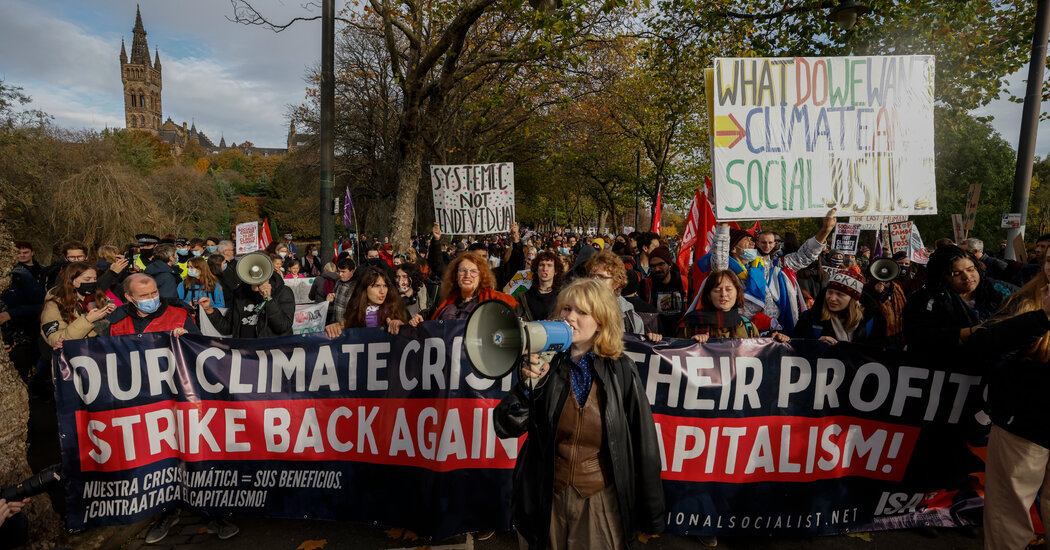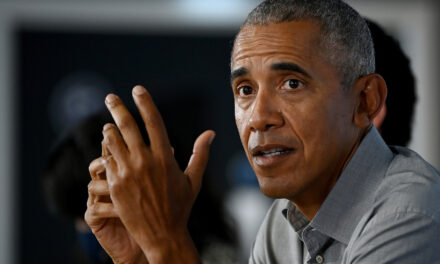
COP26 updates: Thousands Protest for Climate Action at Glasgow Summit

Image

Greta Thunberg, whose 2018 climate strike inspired the international Fridays for Futures movement, joined the thousands-strong throngs of protesters marching in the streets of Glasgow on Friday, demanding action from delegates inside the United Nations climate summit.
Carrying placards and waving flags, people lined the roadways in hopes of catching a glimpse of Ms. Thunberg, the 18-year-old Swedish activist, who was encircled by other, mostly young demonstrators as eager television crews filmed the action.
It was one of the largest protests to take place in Glasgow since the climate talks, known as COP26, began nearly a week ago. Inside the gathering, officials from more than 130 countries are trying to hammer out agreements to avert the most catastrophic consequences of global warming.
Even larger protests are expected on Saturday.
Already, demonstrators have staged theatrical spectacles on street corners, disrupted talks held by companies that are among the world’s biggest carbon emitters, picketed at power plants and hung a banner from a bridge over the River Clyde that read: “Humanity is Failing.”
Announcements by governments and corporations in the first days of the conference — including pledges to end deforestation, phase out coal-fired power plants and mobilize trillions of dollars for green initiatives — have been dismissed by many activists as insufficient or riddled with loopholes.
On Monday, Ms. Thunberg criticized leaders for “pretending to take our futures seriously.”
Throughout the COP26 conference, Ms. Thunberg has been quick to refocus attention away from her own stardom and toward activists from areas of the world that are the worst affected by climate change. On Monday, after she and Vanessa Nakate, a Ugandan climate activist, met with Nicola Sturgeon, the Scottish leader, Ms. Thunberg tweeted: “Media needs to stop erasing the voices of activists, especially the most affected people from the most affected areas.”
Ms. Thunberg is expected to deliver a speech in the afternoon. Vanessa Nakate, a 24-year-old activist from Uganda, is also scheduled to speak.
The crowd on Friday was fronted by a group of Indigenous activists and others from the developing world who called attention to the climate crises facing their communities. They marched behind two lines of police officers, including some on motorcycles who cleared a path through the crowded streets, and carried a banner that read “Divest from Amazon destruction.”
The presence of environmental activists inside the conference, known as COP26, has been muted as pandemic restrictions — on top of difficulty getting vaccines, visas and affordable accommodations — have prevented many global activists from attending.
In particular, activists say, women and people from developing nations are being left out of the most crucial conversations.
Diaka Salena Koroma, a climate activist from Sierra Leone, was unable to attend COP26 despite having been invited to participate, after her visa was delayed. She began campaigning for climate justice after a 2017 mudslide set off by torrential rain killed hundreds in Freetown, her county’s capital.
“We are born in a system where our voices — our existence — doesn’t even matter,” she said.
Image
GLASGOW — A delegation of mothers from Brazil, Britain, India, Nigeria, Poland and South Africa, including one whose daughter last year became the first person in Britain to have air pollution officially listed as her cause of death, arrived at the COP26 climate summit this week with a message to leaders: End the financing of fossil fuels.
On Friday, six mothers delivered a letter to Alok Sharma, the president of the Glasgow gathering, in which they called on world leaders to take action to limit air pollution and protect children who are struggling with its effects. The letter was signed by nearly 500 parent groups from 44 countries.
“I am trying to get justice for my daughter,” said Rosamund Kissi-Debrah, whose 9-year-old daughter suffered a fatal asthma attack in 2013. Ms. Kissi-Debrah said that after reading studies about the dangers of air pollution, she realized that her daughter was not alone.
“This is affecting so many children,” she said in an interview.
The impact of air pollution on human health has become a central issue at the summit, as a growing body of research indicates that climate change has exacerbated health risks around the world.
A study published this year in the journal Nature Climate Change found that more than a third of heat-related deaths in many parts of the world could be attributed to the extra warming associated with climate change. The study was based on climate modeling in 43 countries.
In addition, drier soil contributes to malnutrition, and warming temperatures have contributed to higher numbers of dengue- and malaria-carrying mosquitoes, studies have found.
Air pollution poses one of the biggest threats to human health, according to the World Health Organization. In Delhi, one of the most polluted cities in the world, air pollution in 2019 killed more Indians than any other risk factor. Children from poor families, who spend more time outdoors and are more likely to use wood-burning stoves, are at a much greater risk, according to an investigation by The New York Times.
A W.H.O. report published in September found that exposure to polluted air causes seven million premature deaths each year and can lead to health risks like reduced lung growth and function, respiratory infections and aggravated asthma. In 2019, more than 90 percent of the world’s population lived in areas where concentrations of pollutants exceeded the W.H.O. guidelines.
Kamila Kadzidlowska, an activist from Poland who said her three sons had respiratory health problems because of air pollution, said that the story of her children was not unique.
“It’s the story of most of the parents of small children in Poland,” Ms. Kadzidlowska, who signed the letter to leaders, said at a New York Times event in Glasgow. “I never, ever thought that I would have to fight for something so obvious like the right to breathe clean air.”
Demonstrators have made their voices heard throughout the week as the United Nations climate conference takes place in Glasgow.
Image
GLASGOW — Presidents and prime ministers have left town. Now the hard work starts, with diplomats hunkering down in a cavernous tent complex at the U.N. climate talks here for the next week and a half, trying to hammer out deals to cut planet-warming emissions.
More nations than ever are pledging to reduce emissions, move away from coal, eliminate deforestation and deliver money to help poor countries adapt. Environmental groups and poor nations aren’t as optimistic. They have seen promises come and go before.
Here are five takeaways from the early, frenetic days of the climate conference:
Holding a global conference in a pandemic is hard.
More than 39,000 people are registered for the summit. One problem: Capacity in the main venue is limited to 10,000 people because of Covid restrictions.
That has led to bottlenecks, long security lines and frustration, especially among civil society groups that were already angry that the U.N. had capped their presence inside the negotiating halls.
Everyone entering the venue, known as the “blue zone,” is asked to take a daily rapid coronavirus test. But for all the talk of strict controls, participants simply self-report their results. It’s basically an honor system.
The United States ‘showed up.’
For nearly four years, the United States worked to undermine the progress of climate talks. Former President Donald J. Trump withdrew the United States from the Paris climate agreement and vowed to burn more, not less, gas, oil and coal.
President Biden arrived in Glasgow and flipped the script. He promised to show the world that the United States is “leading by the power of our example.”
Asked about the leaders of other countries, particularly those of China and Russia, who did not attend, Mr. Biden said, “We showed up.”
But some pivotal leaders didn’t.
The absences of President Xi Jinping of China, Vladimir V. Putin of Russia and Jair Bolsonaro of Brazil were notable.
Prime Minister Scott Morrison of Australia did show up — but with an emissions target that experts said falls far short of what’s needed. Brazil pledged to end deforestation by 2028. Activists are skeptical that Mr. Bolsonaro will follow through.
Both Russia and China have targets that, experts say, are not enough to keep the planet on a relatively safe trajectory. Leaving Glasgow, Mr. Biden scolded Mr. Xi and Mr. Putin for not attending. Officials in Beijing hit back, noting Mr. Biden was unable to persuade his own party to vote for climate legislation necessary to meet the United States’ aggressive targets.
Sparring won’t solve the climate crisis. And it remains unclear whether the two biggest emitters, China and the United States, can move past tensions over trade and human rights to work together.
Money was pledged, but will it flow?
Banks and other lenders said they had $130 trillion to finance projects that aim to get companies and countries to net-zero emissions. The number, more than five times the size of the U.S. economy, grabbed headlines.
Environmentalists quickly threw cold water on it, arguing that scant details were provided and that banks still invest hundreds of billions of dollars in fossil fuels each year.
The next target: Ending coal
Poland, Vietnam, Egypt, Chile and Morocco are among 18 countries that will pledge Thursday to phase out coal-fired generation and stop building new plants. The British hosts of the U.N. conference want to leave their mark by ensuring the end of coal “is in sight.”
Yet the issue is deeply contentious. At the start of the summit, the prime minister of Fiji, Frank Bainimarama, told Mr. Morrison of Australia that “coal has no place in this century.” Mr. Morrison has clearly said he won’t discuss fossil fuel mandates or bans.
Expect more pushback in the coming days from Australia, as well as China, India and Russia, to any language formalizing a phaseout of coal in any final decision from the summit.
Image
The United Nations climate change conference in Glasgow is considered a crucial moment for efforts to address the threat of global warming.
Thousands of heads of state, diplomats and activists are meeting to set new targets for cutting emissions from burning coal, oil and gas that are heating the planet. The conference is held annually, but this year is critical because scientists say that nations must make an immediate, sharp pivot away from fossil fuels if they hope to avoid the most catastrophic effects of climate change.
What is the goal?
The goal is to prevent the average global temperature from rising more than 1.5 degrees Celsius compared with levels before the Industrial Revolution. That is the threshold beyond which scientists say the dangers of global warming — such as deadly heat waves, water shortages, crop failures and ecosystem collapse — grow immensely.
What does COP stand for?
The gathering’s name, COP, stands for Conference of the Parties, with “parties” referring in diplomatic parlance to the 197 nations that agreed to the United Nations Framework Convention on Climate Change in 1992. That year, the United States and some other countries ratified the treaty to address “dangerous human interference with the climate system” and stabilize levels of greenhouse gas emissions in the atmosphere.
This is the 26th time countries have gathered under the convention — hence COP26.
What happened at previous talks?
The first COP was in Berlin in 1995, after a critical mass of nations ratified the climate convention. It was a milestone and set the stage two years later for the Kyoto Protocol, which required wealthy, industrialized nations to curb emissions.
That accord had its problems. Among them, the United States under President George W. Bush rejected it, noting that it did not require China, India and other major emerging economies to reduce their greenhouse gases.
Fast-forward to 2015. After more than two decades of disputes over which nations bear the most responsibility for tackling climate change, leaders of nearly 200 countries signed the Paris climate agreement. That deal was considered groundbreaking. For the first time, rich and poor countries agreed to act, albeit at different paces, to tackle climate change.
The United States withdrew from the Paris accord under President Donald J. Trump but rejoined under President Biden.
Although leaders made big promises in Paris, countries have not made sufficient moves to stave off the worst effects of climate change. At the Glasgow conference, which runs through Nov. 12, leaders are under pressure to be more ambitious.
Image
This week and next, New York Times journalists are in Glasgow covering the COP26 climate talks, where officials from more than 130 countries are trying to hammer out agreements to slow the warming of the planet. This year’s conference is seen as crucial for efforts to avert the worst consequences of climate change, and protests are being staged by demonstrators demanding tougher action.
Times journalists on the ground want to hear from you: What questions do you have about the summit and what Glasgow is like during the two-week summit?
Share yours below, and we’ll report the answers in the coming days. We’ll email you after the questions are answered.
Governments are committing to “net zero.” “Eco-friendly” products are being sold on Instagram. Oil and gas companies are promising to become “sustainable.”
As climate change gets worse, many people want others to know that they’re doing something about it. But what do those words mean? Are they really communicating information — or obfuscating it? Consider the debates over “natural gas” versus “fracked gas,” “carbon pricing” rather than “carbon tax,” or “renewable” versus “clean” energy.
Here is a brief user’s guide the term “net zero.”
Scientists have warned that global warming will keep getting worse until humanity reaches “net zero” emissions globally — that is, the point at which we are no longer pumping any additional greenhouse gases into the atmosphere.
So in recent years a growing number of countries and businesses have been pledging to “go net zero” by various dates. But the concept can easily be abused.
Governments or companies are not always promising to stop emitting carbon dioxide altogether. Often they’re saying that they will reduce fossil-fuel emissions from their own factories, homes and cars as much as they can — and then offset whatever they can’t get rid of by, for example, planting trees or using technology to pull carbon out of the air.
Those offsets can be contentious, though. Trees can absorb carbon, but they can also burn in wildfires. Carbon removal technology is still in its infancy. Critics worry that leaders and businesses may be using the uncertain promise of such offsets to avoid making deeper cuts today. And many countries’ net zero pledges are vague and not backed by concrete policies to curb emissions.
Source: https://www.nytimes.com/live/2021/11/05/climate/cop26-glasgow-climate-summit
















